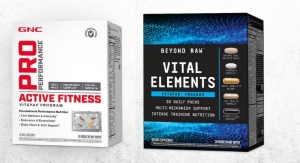06.04.18
The ABC-AHP-NCNPR Botanical Adulterants Prevention Program (BAPP) has released a Botanical Adulterants Bulletin on turmeric (Curcuma longa) rhizome and its extracts.
Few herbal dietary supplement ingredients have seen such a steep sales increase over the past five years as turmeric. Turmeric has been the top-selling dietary supplement in U.S. natural food stores since 2013, and it ranked fifth in sales in mainstream retail outlets in 2017.
The earliest reports of turmeric adulteration were published in the 1970s and 1980s and describe adulteration of turmeric with other Curcuma species, starches, and dyes. More recently, the addition of undeclared synthetic curcumin (one of the naturally occurring curcuminoids in turmeric root and rhizome) or mixtures of synthetic curcuminoids to turmeric extracts has been reported. Synthetic curcuminoids can be sold for about one-third of the cost of natural curcuminoids, providing a financial incentive to fraudulent suppliers for diluting or replacing turmeric extracts with synthetic materials.
The new bulletin, written by Ezra Bejar, PhD, an expert in botanical research in San Diego, CA, lists the known adulterants, details analytical approaches to detect adulterants, and provides information on the nomenclature, cultivation, harvest, and market importance of turmeric. It also discusses safety aspects of the known adulterants. Eighteen laboratory analytical experts from academia, government, and the herb industry have provided input on the bulletin during the peer-review process.
“The increased popularity of herbs like turmeric attracts producers and suppliers who are often more concerned about making a profit than they are about selling a high-quality botanical ingredient,” said Mark Blumenthal, founder and executive director of ABC and director of BAPP. “While there are companies that produce and market high-quality, authentic, reliable turmeric powder and extract supplements, there are also adulterated turmeric ingredients on the market. The BAPP turmeric bulletin is designed to assist purchasing departments and quality control laboratories in the herb, spice, and dietary supplement industries in assuring that responsible companies purchase only authentic turmeric ingredients.”
Stefan Gafner, PhD, chief science officer of ABC and technical director of BAPP, added: “The use of colorants to make the turmeric root visually more attractive is of particular concern. Many of the yellow or orange colorants, such as lead chromate or metanil yellow, may represent a health risk. Since daily dosages of several grams of turmeric powder are recommended for health benefits, use of adulterated turmeric products may lead to an intake of excessive amounts of these colorants.”
The turmeric bulletin is the 14th publication in the series of Botanical Adulterants Bulletins and the 41st peer-reviewed publication published by the program. As with all publications in the program, the bulletins are freely accessible to all ABC members, registered users of the ABC website, and all members of the public on the program’s website (registration required).
The goal of the Botanical Adulterant Bulletins is to provide accounts of ongoing issues related to botanical identity and adulteration, thus allowing quality control personnel and lab technicians in the herbal medicine, botanical ingredient, dietary supplement, cosmetic, herbal tea, conventional food, and other industries where botanical ingredients are used to be informed on adulteration problems that are apparently relatively widespread and/or imply safety concerns.
Few herbal dietary supplement ingredients have seen such a steep sales increase over the past five years as turmeric. Turmeric has been the top-selling dietary supplement in U.S. natural food stores since 2013, and it ranked fifth in sales in mainstream retail outlets in 2017.
The earliest reports of turmeric adulteration were published in the 1970s and 1980s and describe adulteration of turmeric with other Curcuma species, starches, and dyes. More recently, the addition of undeclared synthetic curcumin (one of the naturally occurring curcuminoids in turmeric root and rhizome) or mixtures of synthetic curcuminoids to turmeric extracts has been reported. Synthetic curcuminoids can be sold for about one-third of the cost of natural curcuminoids, providing a financial incentive to fraudulent suppliers for diluting or replacing turmeric extracts with synthetic materials.
The new bulletin, written by Ezra Bejar, PhD, an expert in botanical research in San Diego, CA, lists the known adulterants, details analytical approaches to detect adulterants, and provides information on the nomenclature, cultivation, harvest, and market importance of turmeric. It also discusses safety aspects of the known adulterants. Eighteen laboratory analytical experts from academia, government, and the herb industry have provided input on the bulletin during the peer-review process.
“The increased popularity of herbs like turmeric attracts producers and suppliers who are often more concerned about making a profit than they are about selling a high-quality botanical ingredient,” said Mark Blumenthal, founder and executive director of ABC and director of BAPP. “While there are companies that produce and market high-quality, authentic, reliable turmeric powder and extract supplements, there are also adulterated turmeric ingredients on the market. The BAPP turmeric bulletin is designed to assist purchasing departments and quality control laboratories in the herb, spice, and dietary supplement industries in assuring that responsible companies purchase only authentic turmeric ingredients.”
Stefan Gafner, PhD, chief science officer of ABC and technical director of BAPP, added: “The use of colorants to make the turmeric root visually more attractive is of particular concern. Many of the yellow or orange colorants, such as lead chromate or metanil yellow, may represent a health risk. Since daily dosages of several grams of turmeric powder are recommended for health benefits, use of adulterated turmeric products may lead to an intake of excessive amounts of these colorants.”
The turmeric bulletin is the 14th publication in the series of Botanical Adulterants Bulletins and the 41st peer-reviewed publication published by the program. As with all publications in the program, the bulletins are freely accessible to all ABC members, registered users of the ABC website, and all members of the public on the program’s website (registration required).
The goal of the Botanical Adulterant Bulletins is to provide accounts of ongoing issues related to botanical identity and adulteration, thus allowing quality control personnel and lab technicians in the herbal medicine, botanical ingredient, dietary supplement, cosmetic, herbal tea, conventional food, and other industries where botanical ingredients are used to be informed on adulteration problems that are apparently relatively widespread and/or imply safety concerns.























